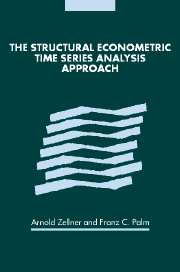Book contents
- Frontmatter
- Contents
- List of contributors
- Acknowledgments
- Introduction
- Part I The SEMTSA approach
- 1 Time series analysis and simultaneous equation econometric models (1974)
- 2 Statistical analysis of econometric models (1979)
- 3 Structural econometric modeling and time series analysis: an integrated approach (1983)
- 4 Time series analysis, forecasting, and econometric modeling: the structural econometric modeling, time series analysis (SEMTSA) approach (1994)
- 5 Large-sample estimation and testing procedures for dynamic equation systems (1980)
- Part II Selected applications
- Part III Macroeconomic forecasting and modeling
- Part IV Disaggregation, forecasting, and modeling
- Subject index
- Author index
- References
1 - Time series analysis and simultaneous equation econometric models (1974)
Published online by Cambridge University Press: 24 October 2009
- Frontmatter
- Contents
- List of contributors
- Acknowledgments
- Introduction
- Part I The SEMTSA approach
- 1 Time series analysis and simultaneous equation econometric models (1974)
- 2 Statistical analysis of econometric models (1979)
- 3 Structural econometric modeling and time series analysis: an integrated approach (1983)
- 4 Time series analysis, forecasting, and econometric modeling: the structural econometric modeling, time series analysis (SEMTSA) approach (1994)
- 5 Large-sample estimation and testing procedures for dynamic equation systems (1980)
- Part II Selected applications
- Part III Macroeconomic forecasting and modeling
- Part IV Disaggregation, forecasting, and modeling
- Subject index
- Author index
- References
Summary
Introduction
In this chapter we take up the analysis of dynamic simultaneous equation models (SEMs) within the context of general linear multiple time series processes such as studied by Quenouille (1957). As noted by Quenouille, if a set of variables is generated by a multiple time series process, it is often possible to solve for the processes generating individual variables, namely the “final equations” of Tinbergen (1940), and these are in the autoregressive-moving average (ARMA) form. ARMA processes have been studied intensively by Box and Jenkins (1970). Further, if a general multiple time series process is appropriately specialized, we obtain a usual dynamic SEM in structural form. By algebraic manipulations, the associated reduced form and transfer function equation systems can be derived. In what follows, these equation systems are presented and their properties and uses are indicated.
It will be shown that assumptions about variables being exogenous, about lags in structural equations of SEMs, and about serial correlation properties of structural disturbance terms have strong implications for the properties of transfer functions and final equations that can be tested. Further, we show how large sample posterior odds and likelihood ratios can be used to appraise alternative hypotheses. In agreement with Pierce and Mason (1971), we believe that testing the implications of structural assumptions for transfer functions and, we add, final equations is an important element in the process of iterating in on a model that is reasonably in accord with the information in a sample of data.
- Type
- Chapter
- Information
- Publisher: Cambridge University PressPrint publication year: 2004



